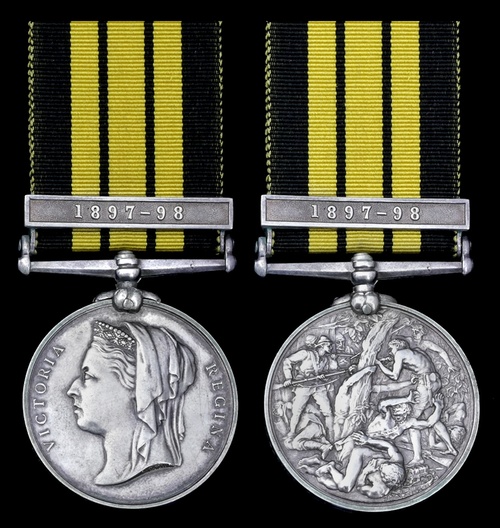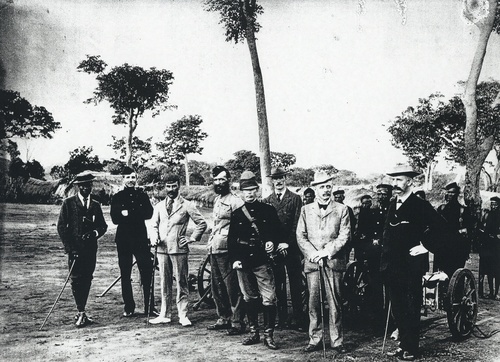Auction: 19002 - Orders, Decorations and Medals
Lot: 40
An important East and West Africa Medal awarded to Assistant Colonial Surgeon J. S. Part, attached Gold Coast Constabulary
A prominent member of Lieutenant F. B. Henderson's force - he of defence of Dawkita fame - Dr. Part was himself present in the fighting around Wa in April 1897 and undoubtedly a witness to the Lieutenant's courageous decision to give himself up to the Sofas
In the interim, Part's replacement surgeon, Dr. Kennedy, died of bee stings and, during the subsequent - chaotic - retreat from Wa, in which he had charge of the wounded, another comrade, the surveyor Mr. George Ferguson, was abandoned by his carriers, captured, shot and beheaded: in fact such was the scale of the stampede enacted by the retreating column's carriers that Dr. Part was knocked down on three occasions
East and West Africa Medal 1887-1900, 1 clasp, 1897-98 (Asst: C. Surgeon J. S. Part, G.C. Constby:), better than very fine
John Shepley Part was born in Derby on 27 October 1864, the son of J. C. Part, a local manufacturer, and attended Derby Grammar School. A keen footballer, he played for Hendon in 1883, but otherwise pursued his chosen career in medicine at Westminster Hospital Medical School. Qualifying as M.R.C.S. and L.R.C.P. in 1888, he continued his studies at Brussels and received the degree of M.D 'avec grande distinction' in 1894.
The Dawkita connection
Appointed an Assistant Colonial Surgeon on the Gold Coast in November 1895, Dr. Part was seconded to the Gold Coast Constabulary and became embroiled in one of the most famous chapters in the 'Scramble for Africa', namely the operations mounted against the rebel leader Samory's Sofas in 1897-98. A small force, under the command of Lieutenant F.B. Henderson, R.N. (Retd.), a Travelling Commissioner acting under the orders of the Governor of the Gold Coast, Sir W. E. Maxwell, set forth to claim new territory and check the slave trade.
On 7 March 1897, Henderson's force, with Part attached as its surgeon, reached Wa, where the Union Flag was raised. Reinforcements then having been requested, Henderson took a small force onwards to Dawkita, where another fort was constructed out of three native compounds. Dr. Part remained at Wa.
What followed has found a place in the annals of Empire, for Henderson and his men were surrounded and attacked by several thousand Sofas. Yet, with a force of just two Europeans and 43 men of the Gold Constabulary, the little garrison held out for four days and nights, prior to effecting a successful retreat to Wa. Amazingly, the defenders suffered just two men killed and eight wounded, while the Sofas are believed to have lost at least 400 warriors.
Henderson and his men were assisted in their retreat by Captains Cramer and Haslewood, who had 50 men, two guns and some rocket launchers, the whole having sallied forth from Wa.
Action at Wa - hectic retreat
On 4 April 1897, a composite force of about 80 men, including Dr. Part, sallied forth from Wa and attacked a substantial force of Sofas, closing to 200 yards. The gallant Doctor, who had charge of a stretcher party, was kept busy, the resultant casualties including three Hausas killed; it was about this time too that Part's replacement, Dr. Kennedy, died from bee stings.
By now encircled, Henderson's position at Wa was hopeless and, in a desperate attempt to save his men, he put his life on the line by suggesting he parley with the enemy Prince, whom he knew to be both 'treacherous and cruel.' Henderson takes up the story:
'I then laid this proposition before the other Officers, who at first opposed the plan on the grounds of the risk I should incur, Ferguson especially saying that I should be uselessly courting death in some unpleasant form. In the end they concurred and a letter was written to the Prince stating that we had not come here to fight his people and could not understand why he had followed me here ... '
The next morning - 5 April 1897 - a Sofa Chief came to collect Henderson, who would endure a terrifying ordeal up until his release in early May.
Meanwhile, as agreed with Henderson, the garrison at Wa evacuated the fort, commencing a march towards Daboya that night. The column departed the fort at 10 p.m. in perfect silence, bringing with it all available guns, ammunition and rockets. After about three quarters of an hour, several shots were fired at the column, shots that caused panic amongst the 400-strong force of carriers, such panic in fact that Dr. Part was three times knocked down in the stampede. His comrade, the ailing Mr. Ferguson, was thrown down in his hammock and lost amidst the chaos that ensued. His fate was only discovered a day later, when his head was brought to the captive Lieutenant Henderson back at Wa.
At length, the military elements of the column rallied round Captain Cramer, and they reached the comparative safety of Daboya. But much blame for the chaotic retreat was apportioned the European officers at a Court of Enquiry held in June 1897, an Enquiry in which Dr. Part - who had care of Mr. Ferguson and the wounded - was among those called to give evidence. Captain Haslewood, who gave the order to abandon the artillery pieces, likewise. It seems the realities of fighting a night action in bush country escaped proper consideration by the Enquiry. Apart from anything else - by necessity - the retreating column extended over two miles.
More certain is the fact Dr. Part was suffering from ill-health. He was invalided home in July 1897 and his Colonial Office contract on the Gold Coast was terminated in the following year.
Subsequent career
In 1900, Part was appointed a District Surgeon and Health Officer in the Malay Straits, where he served until his resignation May 1906. His appointments took him to Selangor and Seremban, in which latter place he also served as a Protector of Labour.
On returning home Part became Honorary Radiographer of the Hospital for Diseases of the Heart, Westminster, London, and of Mount Vernon Hospital for Diseases of the Chest in Fitzroy Square, Northwood. He obtained a commission as a Captain in the R.A.M.C. in the Great War but remained employed on the home establishment.
Dr. Part died at 30, Bath Road, Bedford Park, London on 24 February 1924; sold with a comprehensive file of copied research.
Subject to 20% VAT on Buyer’s Premium. For more information please view Terms and Conditions for Buyers.
Sold for
£1,100
Starting price
£700







